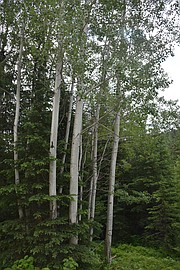Quaking aspen: Trees in the breeze
“Willows whiten, aspens quiver, little breezes dusk and shiver.”
— Alfred Lord Tennyson
Quaking aspen (Populus tremuloides) grow in Boundary County and is the most widely-dispersed tree in North America. It ranges from Alaska to Appalachia and along the Rocky Mountains as far south as New Mexico.
Quaking aspen is America’s liveliest tree. With just the slightest breeze, its round leaves tremble almost incessantly, like thousands of fluttering butterfly wings. One of my favorite sounds in nature is the rustling of aspen leaves in the wind. While most leaves are attached to branches with round stems, quaking aspen have a flat stem that causes the leaf to tremble in the slightest breeze.
Another plus is that aspen trees aren’t usually found by themselves but in groves. So when the leaves tremble, there is a pleasant all-around sound.
The aspen forms large stands of genetically-identical trees connected by a single underground root system. These trees form through root sprouts coming off an original parent tree.
Quaking aspen can be easily recognized by their smooth, white bark, marked by dark scars where branches naturally self-prune. Adult aspen reach 40 to 70 feet high but occasionally grow much taller. The largest in the United States, a giant of 144 feet, is in the Kootenai National Forest near Troy, Montana.
Aspen groves provide a lot of food for wildlife. Bears, deer, elk, moose, snowshoe hares, porcupines, beavers, and other wildlife eat aspen leaves, twigs, and bark, especially in winter. Birds love quaking aspen groves and the rich understory of shrubs, grasses, and wildflowers. When walking through a grove, look for rows of small black holes made by red-napped sapsuckers searching for insects. Other bird species using aspen are mountain bluebirds, house wrens, thrushes and ruffed grouse. The tree is also a host to a myriad of butterflies.
Aspen grow in dense groves ranging from one to 20 acres within ponderosa pine, Douglas fir, and lodgepole pine forests. Aspens need more moisture than conifers do, so they grow best along streams and sheltered areas such as swales.
The heart-shaped leaves have finely saw-toothed edges. They are attached to branches by a stem that is flat rather than round, which causes the leaves to tremble (or quake) in the slightest breeze. Dark green leaves above and light below seem to shimmer as they flutter in the wind. Some botanists believe that quaking aspen leaves twist and turn to dissipate the force of strong winds that could snap the tree trunk, Quaking aspen are also known as quakies and trembling aspen.
Aspen holds the title of largest living organism. The reason is that aspen grow in stands (called clones) and reproduce primarily by sending up sprouts from their roots. This means that virtually all the trees in a clone are connected. In Utah, where it serves as the state tree, one clone was observed to have 47,000 stems. It’s estimated that this interlinked organism weighs 6,000 tons. While individual aspen trees live a vigorous 100-150 years, a clone in Minnesota has been estimated to be 8,000 years old, making it one of the oldest living things on earth.
Take some time this year and visit an aspen stand in Boundary County. Find a sunny spot, lay or sit down on the ground and listen to the trees whisper to one another as they make their quaking sound. The soft whispering rustle of a quaking aspen is unlike the sound of any other tree in the forest.



